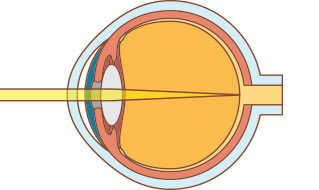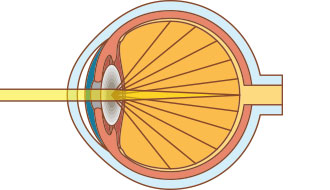Cataracts
A cataract typically manifests as a cloudy structure inside the eye that reduces the amount of light that can pass through to the retina.
Cataracts are some of the most common vision conditions affecting older Americans, and they can even occur in younger patients. Characterized by a clouding of the eye’s natural lens, cataracts lead to the loss of near vision (presbyopia) and the need for bifocals or reading glasses. Since cataracts are progressive conditions, they can ultimately lead to a significant loss of vision – and even blindness – if left untreated.
Although cataracts are serious eye conditions that will affect most everyone at some point in their lives, advances in the field of cataract surgery have made it possible to effectively remove this threat to one’s vision and simultaneously address common visual refractive errors. There has been a rapid evolution in cataract treatment over the past few years, which has brought about state-of-the-art procedures designed to eliminate cataracts and improve vision without the need for extensive recovery periods. At New Eyes, our experienced cataract surgeons – Drs. Helga F. Pizio, Ksenia Stafeeva, Emily Schorr, Devasis Reddy, and Parisah Moghaddampour – offer some of the latest cataract removal techniques in addition to advanced intraocular lens options that can help you achieve clearer vision at a range of distances.
Please follow the links below for more information on cataracts and the procedures we offer, and contact us today with any questions you may have.
What is a Cataract?
A cataract typically manifests as a cloudy structure on the eye that reduces the amount of light that can pass through to the retina. Millions of people are affected by cataracts. In fact, it has been estimated that more than half of all Americans will have a cataract or will have already had cataract surgery by the time they are 80 years of age. Cataracts are the leading cause of blindness throughout the world. With regular eye exams and early treatment, cataracts can often be successfully removed and threats to one’s vision significantly reduced.

In a normal eye, light is focused through the lens relaying a clear image to the brain.

If the lens is cloudy from a cataract, the light is filtered and scattered. The image you see will be blurry.
Types of Cataracts
While all cataracts involve clouding of the eye’s natural lens, there are three main types of cataracts—nuclear, subcapsular, and cortical:
- Nuclear cataracts are cataracts that have formed around the center (nucleus) of the eye’s lens, usually causing it to become brown or yellow in color. This type of cataract is most often associated with aging.
- Subcapsular cataracts, also known as posterior cataracts, form at the back of the eye’s lens. This type of cataract generally forms more rapidly than the other two types, and is most frequently related to individuals with diabetes or who have taken high doses of steroid medications.
- Cortical cataracts occur in the outside edges of the eye’s lens, known as the cortex. These opaque white cataracts are wedge shaped, and gradually extend out towards the center of the lens in a spoke-like pattern.
Can Cataracts Be Prevented?
Although there is no scientific proof that cataracts can be prevented, there are several steps you can take that may potentially reduce (or delay) your risk of developing cataracts, such as:
Practicing Healthy Lifestyle Choices
- Wear eyewear with 100% UV protection when you are outdoors
- Quit smoking, and limit alcohol consumption
- Remain active and maintain a healthy weight
Eating Right
- Consume foods rich in vitamins and antioxidants, like seeds, nuts, and other leafy greens
- Eat fish and/or other foods that contain omega-3 fatty acids
- Take certain vitamin supplements, including vitamin E and vitamin C to make up for nutrients not consumed through your regular diet
Being Proactive
- Even if your vision is clear and seems healthy, be sure to schedule annual eye exams
- Remember to stay on top of medical conditions, such as diabetes
What Causes Cataracts?
While cataracts typically develop as a result of the natural process of aging, they can also be linked to an injury to the eye, some types of diseases (including diabetes), smoking, excessive exposure to ultraviolet rays, and even certain medications. Cataracts ultimately cause the eye’s natural lens to become cloudy, impairing its ability to properly focus light.
Symptoms of Cataracts
- Blurry, cloudy, and/or dulled vision
- Sensitivity to light
- A “halo” effect surrounding lights
- Double-vision
- Glare
- “Ghost” images
- Color distortion – a fading or yellowing effect on objects
- The frequent need to change prescriptions for glasses or contacts
- Difficulty seeing at night
- The need for additional lighting in order to see clearly while reading or participating in other activities
- Progressive and significant loss of vision
Glaucoma vs. Cataracts
Both glaucoma and cataracts are conditions that cause vision deterioration and tend to be more common in diabetics. However, there are some important differences that set them apart.
Glaucoma can develop quickly and painfully, but can also sometimes be gradual and subdued. Cataracts, on the other hand, typically worsen over time and do not cause pain. A cataract affects vision by clouding the eye’s lens and can be corrected through cataract surgery; glaucoma creates a buildup of pressure in the eye that ultimately causes irreversible damage to the optic nerve. Glaucoma treatments can help control the disease and/or prevent further damage, but the loss of vision caused by glaucoma is permanent, so immediate care is critical.
Can Cataracts Come Back?
It is not possible for a cataract to form after cataract surgery has been performed, because the eye’s natural lens is removed as part of the procedure. The lens is replaced with an IOL, which cannot develop a cataract. Over time, though, a small percentage of cataract surgery patients may experience a condition called capsular opacification. The effects of capsular opacification are similar to the symptoms of cataracts, but it is actually a clouding of the lens capsule (the membrane that previously surrounded the lens). Capsular opacification can usually be resolved relatively quickly and easily with a specialized laser designed to allow light to pass through the eye again.
Cataract Treatment Options
At New Eyes, we offer both traditional and SMART cataract surgery to eliminate cataracts. Each technique involves small incisions made in both the cornea and the lens capsule. The key difference is how the incisions are made—either manually with a blade or via a highly precise, technologically-advanced laser. Through these incisions, your surgeon can access the clouded lens and emulsify (break down) the cataract. Once the cataract has been fragmented, it can be easily removed with a tiny vacuum.
Learn More About SMART Cataract Surgery
After the cataract is removed, the natural lens can be replaced with an intraocular lens (IOL). We offer a wide variety of IOLs, each with unique benefits. Prior to surgery, your surgeon can discuss these options with you and help you determine which type of IOL is most appropriate.
Cataract Surgery Process
From the initial eye exam to recovery from cataract surgery, New Eyes can walk you through the treatment process and let you know what to expect.
Learn More about the Cataract Surgery Process
Contact New Eyes for More Information
If you have questions about cataracts and the treatments available at New Eyes, or if you would like to schedule a consultation, please contact us today.
